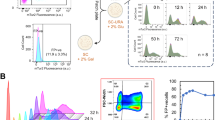Abstract
A recombinant strain of Saccharomyces cerevisiae, containing a 2-μm-fragment-based plasmid (pYEαa4) was grown under non-selective conditions in continuous culture. The decrease in the population carrying the plasmid-encoded auxotrophic marker, LEU2, was examined under different physiological conditions. The difference in growth rate (Δµ) between plasmid-free and plasmid-containing cells and the rate of plasmid segregation (R) were determined using a non-linear regression technique. Loss rates were greater in defined glucose-limited cultures than in complex glucose-limited cultures. Plasmid loss was Δµ-dominated in cultures grown on defined media whereas Δµ and R were co-dominant in cultures grown on complex medium. Loss rates increased with increasing dilution rate in complex glucose-limited cultures. The reverse was found in defined glucose-limited cultures. Plasmid retention and loss kinetics determined from defined magnesium-limited cultures were not significantly different from those observed in defined glucose-limited cultures. Although plasmid retention in defined phosphate-limited culture was not significantly different from that in defined glucose-limited culture, reduced R and increased Δµ indicated an alternative physiological effect of phosphate limitation on plasmid stability.
Similar content being viewed by others
References
Berry DR, Brown C (1987) Physiology of yeast growth. Yeast Biotechnology. Allen & Unwin, London, pp 161–199
Bugeja VC, Kleinman MJ, Stanbury PF, Gingold EB (1989) The segregation of the 2 μm-based yeast plasmid breaks down under conditions of slow, glucose limited growth. J Gen Microbiol 135:2891–2897
Caulcott CA, Dunn A, Robertson HA, Cooper NS, Brown ME, Rhodes PM (1987) Investigation of the effect of the growth environment on the stability of low-copy-number plasmid in Escherichia coli. J Gen Microbiol 133:1881–1889
Cooper NS, Brown ME, Caulcott CA (1987) A mathematical model for analysing plasmid stability in microorganisms. J Gen Microbiol 133:1871–1880
Davidson AM, Dunn A, Day MJ, Randerson PF (1990) A nonlinear technique for the analysis of plasmid instability in microorganisms. J Gen Microbiol 136:59–64
Dibiasio D, Sardonini C (1986) Stability of continuous culture with recombinant organisms. Ann N Y Acad Sci 469:111–117
Fleming G, Dawson MT, Patching JW (1988) The isolation of strains of Bacillus subtilis showing improved plasmid stability characteristics by means of selective continuous culture. J Gen Microbiol 134:2095–2101
Fleming GT, Patching JW (1994) Plasmid instability in an industrial strain of Bacillus subtilis grown in continuous culture. J Ind Microbiol 13:106–111
Goldberg I, Er-el Z (1981) The chemostat- an efficient technique for medium optimization. Process Biochem 16:2–8
Guthrie C, Fink GR (eds) (1991) Guide to yeast genetics and molecular biology. Methods Enzymol 194:3–21
Impoolsup A, Caunt P, Greenfield PF (1989) Effect of growth rate on stability of a recombinant plasmid during continuous culture of Saccharomyces cerevisiae in non-selective medium. J Biotechnol 10:171–180
Jones SA, Melling J (1984) Persistence of pBR322-related plasmids in Escherichia coli grown in chemostat culture. FEMS Microbiol Lett 22:239–243
Kleinman MJ, Gingold EB, Stanbury PF (1986) The stability of the yeast plasmid pJDB248 depends on the growth rate of the culture. Biotechnol Lett 8:225–230
Lee FS, Hassan HM (1988) Stability and expression of a plasmid-encoded killer toxin cDNA in batch and chemostat cultures of Saccharomyces cerevisiae. Biotechnol Bioeng 31:783–789
Lenski RE, Bouma JE (1987) Effects of segregation and selection on instability of plasmid pACYC184 in Escherichia coli B. J Bacteriol 169:5314–5316
Longtime MS, Enomoto S, Finstad SL, Berman J (1993) Telomere-mediated plasmid segregation in Saccharomyces cerevisiae involves gene products required for transcriptional repression at silencers and telomeres. Genetics 133:171–182
Matsui T, Sato S, Mukataka S, Takahashi J (1990) Effect of nutritional conditions on plasmid stability and production of tryptophan synthase by a recombinant Escherichia coli. Agric Biol Chem 54:619–624
Noack D, Roth M, Geuther R, Muller G, Undisz K (1981) Maintenance and genetic stability of vector plasmids pBR322 and pBR325 in Escherichia coli K12 strains grown in a chemostat. Mol Gen Genet 184:121–124
O'Kennedy R, Camplisson S, Patching JW (1994) Microsoft® Excel Macros for analysing plasmid instability and their application to recombinant strains of Saccharomyces cerevisiae. Binary 6:204–216
Robinson JA (1985) Determining microbial kinetic parameters using nonlinear regression. In: Advances in Microbial Ecology. Plenum Press, New York, pp 61–114
Ruohonen L, Penttila M, Keranen S (1991) Optimization of Bacillus α-amylase production by Saccharomyces cerevisiae. Yeast 7: 337–346
Seigul R, Ryu DDY (1985) Kinetic study of instability of recombinant plasmid pPLc23 trpA1 in E. coli using a two-stage continuous culture system. Biotechnol Bioeng 27:28–33
Summers DK (1991) The kinetics of plasmid loss. Trends Biotechnol 9:273–278
Wei D, Parulekar SJ, Stark BC, Weigand WA (1989) Plasmid stability and α-amylase production in batch and continuous cultures of Bacillus subtilis TN106[pAT5]. Biotechnol Bioeng 33:1010–1020
Wickerman LJ (1946) A critical evaluation of the nitrogen assimilation tests commonly used in the classification of yeasts. J Bacteriol 52:293–301
Wouters JTM, Dreihuis FL, Polaczek PJ, Oppernraay MLHA van, Andel JG van (1980) Persistence of the pBR322 plasmid in Escherichia coli K12 grown in chemostat cultures. Antonie van Leeuwenhoek 46:353–362
Author information
Authors and Affiliations
Rights and permissions
About this article
Cite this article
O'Kennedy, R., Houghton, C.J. & Patching, J.W. Effects of growth environment on recombinant plasmid stability in Saccharomyces cerevisiae grown in continuous culture. Appl Microbiol Biotechnol 44, 126–132 (1995). https://doi.org/10.1007/BF00164491
Received:
Revised:
Accepted:
Issue Date:
DOI: https://doi.org/10.1007/BF00164491




